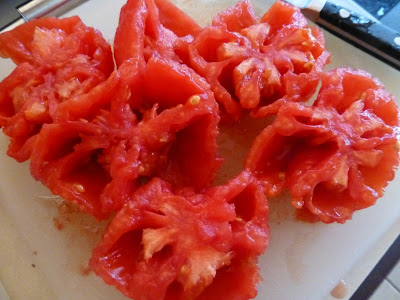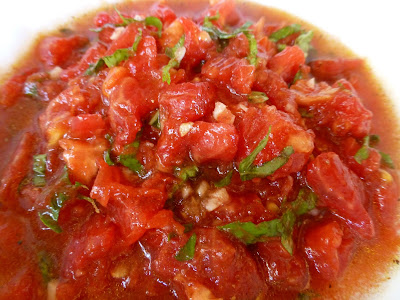 |
| Stuff cherry tomatoes with store-bought hummus for a quick and easy appetizer! Follow Foods For Long Life on FACEBOOK. |
Cherry Tomatoes Stuffed with Hummus
If you have a cherry tomato plant in your garden you are probably buried in these little fruits. Besides popping them in your mouth or tossing them in a salad, here's a quick and easy way to turn them into a tasty appetizer.
Start with large cherry tomatoes - the real tiny ones are not good candidates for this.
 |
| Use large cherry tomatoes for stuffing |
If you are in a hurry, buy some ready-made hummus in the grocery store. Hummus is very easy to make but it's even easier to buy. So if you have some last minute guests and a bunch of cherry tomatoes, pick up a tub. I've seen some very interesting flavors too. Whole foods has their own brand that's very well priced (less than $3.00) and comes in several flavors including lemon, garlic, red pepper, olive, and traditional. Get a brand that is firm so it holds up in the pastry bag.
Cut the tops off of the cherry tomatoes and hollow them out. I gently dislodge the seed cluster with a tomato knife and then scoop the seeds out with a tiny spoon. Remove all the moisture.
 |
| Cherry tomatoes ready for filling |
Place the hummus in a pastry bag with a pretty large tip so that the hummus will flow through it easily. Fill each cherry tomato.
 |
| Fill the cherry tomatoes with hummus using a pastry bag. |
If you really want to get fancy, you can serve them on their tops! Warning: It's a bit tricky to get them to stay on.
 |
| Served on their tops |
Vegan Tomato Caprese with Hummus
If you're lactose intolerant like me you have to avoid mozzarella, the main ingredient of Tomato Caprese salad. But there are several ways to still enjoy this wonderful Italian dish.
You can substitute a spoonful of firm hummus for each slice of mozzarella. Just slice the top and bottom from a nice heirloom tomato and cut the rest of the tomato into 3 thick slices. Use one tomato, 3 heaping tablespoons of hummus, some chopped fresh basil, 1 teaspoon of hemp or olive oil, and some freshly ground black pepper for each serving.
Build the Caprese salad by placing one slice of tomato on a small plate. Place a heaping tablespoon of hummus over the tomato slice, then another tomato slice, another layer of hummus, a final tomato slice, and a final layer of hummus.
Sprinkle some chopped fresh basil and freshly ground black pepper over the tomatoes and drizzle a teaspoon of cold-pressed hemp oil or extra virgin olive oil over each salad. Serve immediately.
 |
| Hummus Caprese Salad |
To make a vegan caprese that tastes more like cheese, see my recipe for Raw Vegan Caprese Salad that uses a simple cashew "cheese" to replace the mozzarella.
If you enjoyed these ideas, check out my eBook, Health Begins in the Kitchen!



































